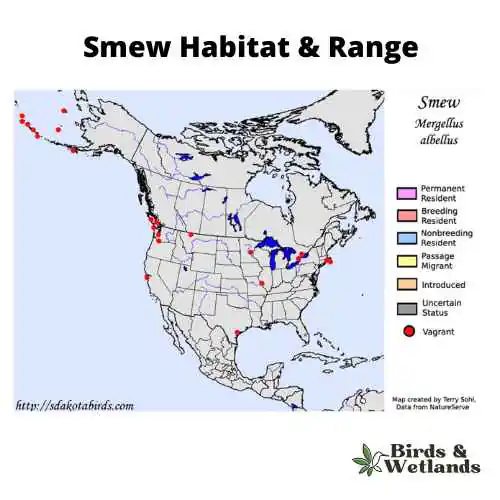
The smew is a small diving duck and the only extant species of the genus Mergullus. It is often grouped together with the genus Mergus members but is closely related to the goldeneyes. It is not uncommon for the smew and common goldeneye or tufted duck to hybridize.
Scientific Name: Mergellus albellus
Length: 38–44 cm (15–17 in)
Wingspan: 56–69 cm
Weight: 450–650 g
Physical Description

The adult male smew in breeding plumage has a mostly white body with a black back, contrasting with the pale gray flanks.
The breast is marked with two narrow black lines, and the flight feathers are black. The tail and rump are dark gray, and the head is mostly white with a black mask that extends over the eyes and around the base of the bill.
The male smew has a few black feathers on the nape, contrasting with the white, elongated crest feathers. It has a short gray bill with serrated edges and dark reddish brown eyes. The legs and webbed feet are gray.
Males are sometimes called white nuns due to their mostly white plumage.
The adult female smew has a rufous-brown nape and hindneck, with a white throat and lower cheeks. The upperparts and tail are grey, and the wings show less white pattern than in the male. The flanks are mottled gray, becoming darker on the rear sides.
Listen to the Smew
Habitat & Range

The smew is a duck found in the Northern Hemisphere, known for its large head and short tail with a white patch on its wings. It can be found in open wetlands with a lot of trees and estuaries in Europe and Asia, including marshes, bogs, reed beds, lakes, and rivers.
During migration, this wild bird can also be seen in small flocks near coastal areas such as harbors and estuaries.
In east Asia, this waterfowl is found throughout China and eastern Siberia, as well as much of Japan.
Most European populations migrate to sheltered coasts of northern Germany, France, Spain, and Portugal during very cold weather, while Asian populations migrate to southern China or Korea.
It is a rare winter visitor in North America. Small numbers visit the Aleutian Islands annually.
Feeding Habits & Diet
The smew is an efficient predator that feeds primarily on aquatic insects and small fish. It prefers to dive and swim underwater to catch its prey using its hooked-tipped bill.
To maximize efficiency, the smew swims along weed beds and other structures to find food. In the winter, it may also eat crustaceans like shrimp or crayfish. It may also hover over the water to catch flying insects.
Nesting & Mating Habits

The breeding season of smews depends on their location. In the south, it usually starts in late March to May, while in the north, it begins in May to June. These birds fly to their breeding grounds in early spring.
Smews prefer to nest alone or in small groups, using abandoned holes or nest boxes at least 10 meters above the ground. Some smews reuse abandoned nests of woodpeckers.
The female lays 6 to 9 cream-colored eggs, incubating them for 26-28 days, while the male molts. Ducklings are precocial and can feed themselves hours after hatching.
Threats & Conservation

The International Union for Conservation of Nature (IUCN) currently assesses the smew as Least Concern due to its wide range and population distribution.
However, the smew is still vulnerable, and it estimates that its global population has declined by more than 20% since 2000.
Key Points
- Smews are diving ducks found in the northern hemisphere.
- The smew lives in the northern regions of Eurasia.
- Females nest in tree holes and sometimes reuse abandoned nests by woodpeckers.
